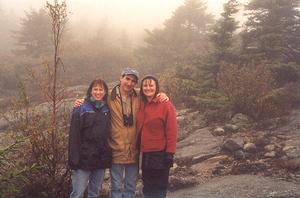
1. Dr. Rob Craig (center), Barbara, his lovely wife (right) and an assistant (left) in the field on Mt. Monadnock on a wet day... still, they smile!
Part IX: The Crow and Round Robin to BCR
The American Crow displays extraordinary intelligence. Observers have occasionally noted that Crows drop stones utilizing them as tools on nuts cracking shells to get to the meats. They will also pound nuts with small stones held in their beaks to expose the tasty hearts. Crows, too, will steal the catch from ice fishermen pulling up the lines alternating beak and talon when fishermen are not looking. Drawn to small bright objects they fly off with them for apparently no other reason than vanity. Crows can make very good pets if you should stumble upon young ones that have lost their parents. As with Mina Birds some learn to mimic the human voice.
In the folklore of many cultures and numerous indigenous tribes Crows represent the spiritual often associated with death. Being true omnivores they can be a nuisance if not a downright menace to farmers. But they also consume enormous quantities cutworms and grasshoppers that are a bane to gardeners and farmers alike.
There was an American Crow with a difference. I spotted him many times over the course of two years when family lived in Colchester. He was special because several feathers on his left wing were pure white in stark contrast to his iridescent black plumage. This mutation seemed not to affect the way his fellow Crows treated him. He was as much a member of the murder as were his brethren. (A flock of Crows is called a “murder”. Isn’t that dark fun?) I looked for him in the third year but sadly never saw him again.
Coming round robin Dr. Robert Craig (see pic 1) in a forthright sober tone stated that man’s continuous development impacts feathered neighbors in many ways. Poorly planned “sprawl” and seemingly endless strings of blocky building lots all too often tatters habitats inflicting devastation upon many species. Some deep forest bird species will not conform to living at the fringes. Many wetland species, especially amphibians, require very clean swamps, marshes and waterways. Some mammals roam large territorial tracts.
Towns would be wise to consider regulations that would facilitate wildlife corridors. These swaths of land would afford greater possibility that wild habitats be connected one to the next. These strings of connections in turn would make more facile confluence from one ecosystem to the next, from marsh to pond to field to woodland to forest. Clearly, wildlife corridors would be of great benefit to all manner of creatures, great and small and most especially to those that will not conform to suburbia.
Smart growth policies should be implemented now before the next wave of development makes it yet more difficult to connect wildlife pathways. Dr. Craig’s texts can be of help to wetland, zoning and conservation boards and commissions which are interested in making informed land set-asides. These texts will illuminate aiding planners in making smarter choices in conjunction with other layers of information.
Restating, Dr. Craig’s texts: Forest Birds of the Last Green Valley (see pic 2) and Discover the Critical Habitats of Connecticut are tremendously useful tools for towns considering land set-asides and smart growth policies. Anyone interested in procuring these books can telephone at (860) 928-2178 or go to the website at www.birdconservationresearch.org. And be sure to keep an eye out for the new resource atlas, Forest Birds of Connecticut and Rhode Island.
I have settled in Brooklyn, Connecticut but lived in New York City for many years. There I saw first hand how development had demolished ecosystems. The most prevalent birds were Pigeons, English House Sparrows and Seagulls. And having seen it from both sides I choose the wilder, greener and richer world of the Quiet Corner. One of the more brilliant folk and pop artists of our time, Joni Mitchell, sang “Don’t it always seem to go that you don’t know what you’ve got ‘til it’s gone. They paved paradise and put up a parking lot.”
Please consider helping not only our feathered neighbors (see pic 3) but all the marvelous and varied genera with who we share land, water and sky. Protecting open space in its many forms protects us, our drinking water, expands quality of life for all and it lessens our carbon footprint as a species. It may even garner us extra karma points! Whether feathered, scaled or furred we can save ecosystems and habitats in the Last Green Valley while time and space remains. If we do so future generations can enjoy and appreciate this region we have so come to love.
And looking up and out the sliding doors while I administer finishing touches a flock of Mourning Doves suddenly has become airborne just as an Exaltation of Larks has arisen from my pen for your edification, enjoyment and wonder. Peace. (See pic 4)

